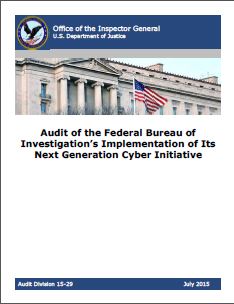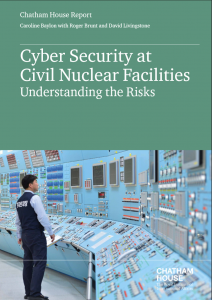Chatham House conducted a year long study from 2014-2015 on the state of the cybersecurity of the world’s civil nuclear facilities. To gather data for this report, Chatham House undertook literature review, interviewed practitioners in the fields of cybersecurity and nuclear issues, conducted roundtable workshops bringing together cybersecurity and nuclear experts from both the private and government sectors, and presented the findings and solicited feedback from experts at two NATO Advanced Research Workshops.
According to the report, titled Cyber Security at Civil Nuclear Facilities: Understanding the Risks, Chatham House found that cybersecurity risks at civil nuclear facilities are growing because:
- Civil nuclear facilities are increasingly using commercial ‘off-the-shelf’ (“COTS”) software, which reduces costs but increases risk from hacking attacks;
- The lack of awareness in the executive-level combined with the trend of digitization results in the lack of awareness and preparedness of personnel at the operation level of nuclear facilities;
- The belief of a myth that nuclear facilities are not subject to cyber attacks because they are ‘air gapped’, meaning that they are completely isolated from the public internet;
- Hacking is increasingly becoming easier to conduct and has become more widespread.
Further, the report identified major industry-wide, cultural, and technical challenges that civil nuclear facilities are currently facing, including:
- The true extent of cyber threats are not being realized because of the lack of disclosure of cybersecurity incidents and collaboration with other industries that are more advanced in the area of cybersecurity;
- There are scarce regulatory standards, meaning that the industry’s risk assessment standards may be inadequate;
- Civil nuclear facilities in developing nations are particularly at risk because they have fewer resources to invest in cybersecurity;
- There is a lack of communication between the cybersecurity personnel and nuclear plant personnel, which leads to the lack understanding of key cybersecurity procedures by nuclear plant personnel;
- Personnel at civil nuclear facilities lack preparedness for a cybersecurity emergency because there are very little cybersecurity training and drills;
- Many industrial control systems, more commonly known as SCADA systems, are ‘insecure by design’ because they were not developed with security in mind;
- Patching these control systems are often difficult because they require the nuclear facility to reduce capacity.
The report ends with recommendations to address the specific risks identified that afflict the industry including:
- Developed guidelines to measure cybersecurity risk in the industry;
- Promote cyber insurance, which can help develop stronger risk assessments;
- Increase dialogue between nuclear facility personnel and cybersecurity personnel to raise awareness of the cybersecurity risks involved in the industry;
- Establish rules already not in place that will help change the cultural attitude toward cybersecurity, such as banning the use of personal USB devices on facility systems and changing default passwords.
Chatham House went further to include recommendations to develop international policy measures for nuclear facilities including:
- Providing technical assistance and financial resources to developing nations to improve their cybersecurity capabilities. (Interestingly enough, this very same suggestion was made by a UN group in the context of the cybersecurity of information and communications technologies (“ICTs”));
- Countries should be encouraged to adopt an effective regulatory approach to cybersecurity at nuclear facilities. Most large nations already follow the Intentional Atomic Energy Agency’s (“IAEA”) guidance, so the report suggests that more resources should be provided to the IAEA to enable it to develop such recommendations and guidelines.
The full report can be found here.





Leave a Reply